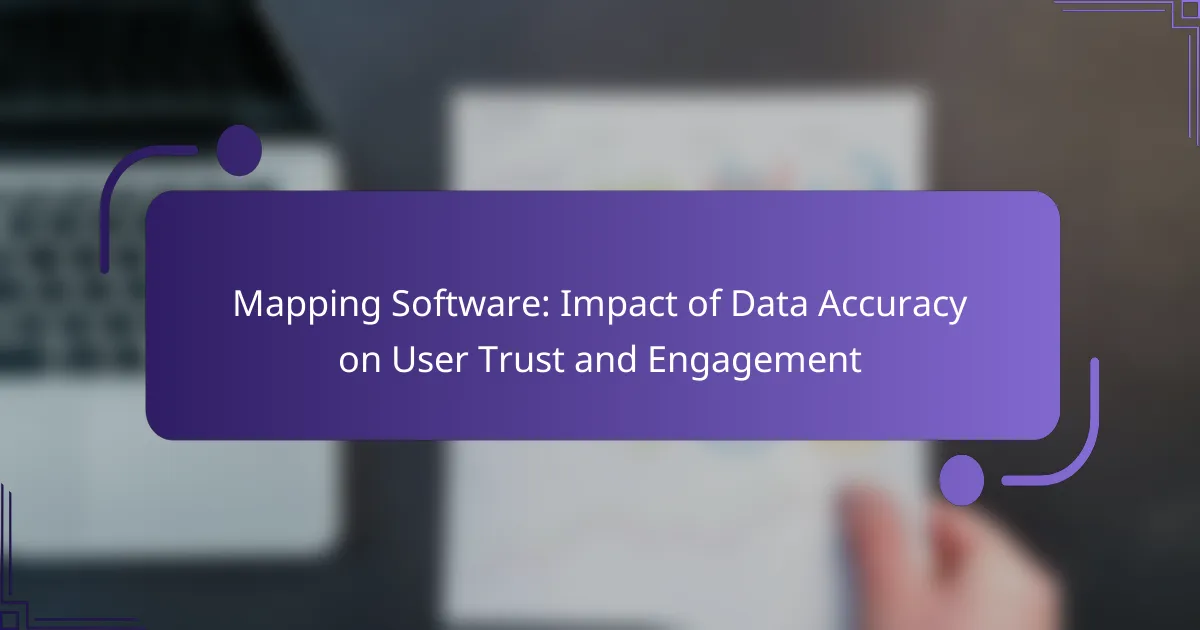The accuracy of data in mapping software plays a crucial role in establishing user trust and fostering engagement. When users are confident in the precision of the information provided, they are more inclined to rely on the software for navigation and other needs. Enhancing data accuracy through timely updates and advanced analytics not only boosts reliability but also strengthens user relationships with the platform.

How does data accuracy impact user trust in mapping software?
Data accuracy significantly influences user trust in mapping software by ensuring reliable navigation and dependable information. When users perceive that the data is precise, they are more likely to engage with the software and rely on it for their navigation needs.
Increased reliability of navigation
Accurate data enhances the reliability of navigation systems, allowing users to reach their destinations without unnecessary detours. For instance, a mapping application that provides real-time traffic updates based on precise data can guide users through the fastest routes, minimizing travel time.
Users are more inclined to trust navigation software that consistently delivers accurate directions, leading to increased usage and loyalty. This reliability is crucial for applications used in critical situations, such as emergency services or logistics.
Enhanced user satisfaction
When mapping software delivers accurate and timely information, user satisfaction tends to increase significantly. Users appreciate having access to reliable data that helps them make informed decisions about their routes and travel plans.
For example, a user who finds a restaurant via a mapping app that accurately reflects its location and hours is likely to have a positive experience, leading to higher satisfaction and potential recommendations to others.
Reduction in errors
Data accuracy plays a vital role in reducing errors within mapping software, such as incorrect locations or outdated information. By minimizing these errors, users can avoid frustrating situations that arise from following inaccurate directions.
Regular updates and validation of mapping data can help maintain accuracy, ensuring that users receive the most current information. This proactive approach can significantly reduce the likelihood of errors that could lead to lost time or confusion.
Improved decision-making
Accurate data empowers users to make better decisions regarding their travel and navigation choices. With reliable information, users can assess various routes, estimated travel times, and potential obstacles effectively.
For instance, a mapping application that accurately displays traffic conditions allows users to choose alternative routes proactively, leading to more efficient travel. This capability is particularly beneficial for businesses that rely on timely deliveries and efficient logistics management.

What features enhance data accuracy in mapping software?
Data accuracy in mapping software is significantly enhanced by features that ensure timely updates, integration of advanced analytics, validation of user contributions, and the application of machine learning techniques. These elements work together to improve the reliability and trustworthiness of the information presented to users.
Real-time data updates
Real-time data updates are crucial for maintaining the accuracy of mapping software. They allow users to access the most current information, such as traffic conditions, road closures, or weather changes, which can affect navigation and planning. Implementing systems that refresh data frequently, ideally within seconds to minutes, can greatly enhance user trust.
For example, mapping applications that integrate live traffic data can adjust routes dynamically, providing users with the fastest paths based on current conditions. This responsiveness not only improves user experience but also fosters confidence in the software’s reliability.
Geospatial analytics integration
Integrating geospatial analytics into mapping software enhances data accuracy by providing deeper insights into spatial relationships and patterns. This feature allows for the analysis of large datasets to identify trends, such as population density or resource distribution, which can inform better decision-making.
For instance, urban planners can utilize geospatial analytics to visualize and predict the impact of new developments on traffic flow. By leveraging this data, mapping software can offer more accurate recommendations tailored to specific geographic contexts.
User-generated content validation
User-generated content validation is essential for ensuring the accuracy of information contributed by users. This process involves verifying the reliability of user inputs, such as new landmarks or route suggestions, through community feedback or expert review. Implementing a robust validation system can significantly enhance the trustworthiness of user contributions.
Mapping platforms often encourage users to report inaccuracies, rewarding them for their efforts. This not only helps maintain data quality but also engages the community, making users feel invested in the platform’s accuracy.
Machine learning algorithms
Machine learning algorithms play a pivotal role in enhancing data accuracy by analyzing patterns and predicting future trends based on historical data. These algorithms can automatically detect anomalies or inconsistencies in mapping data, allowing for timely corrections and updates.
For example, a mapping software might use machine learning to identify frequently reported errors in specific areas, prompting proactive updates. By continuously learning from user interactions and data inputs, these algorithms help ensure that the mapping software remains accurate and relevant over time.
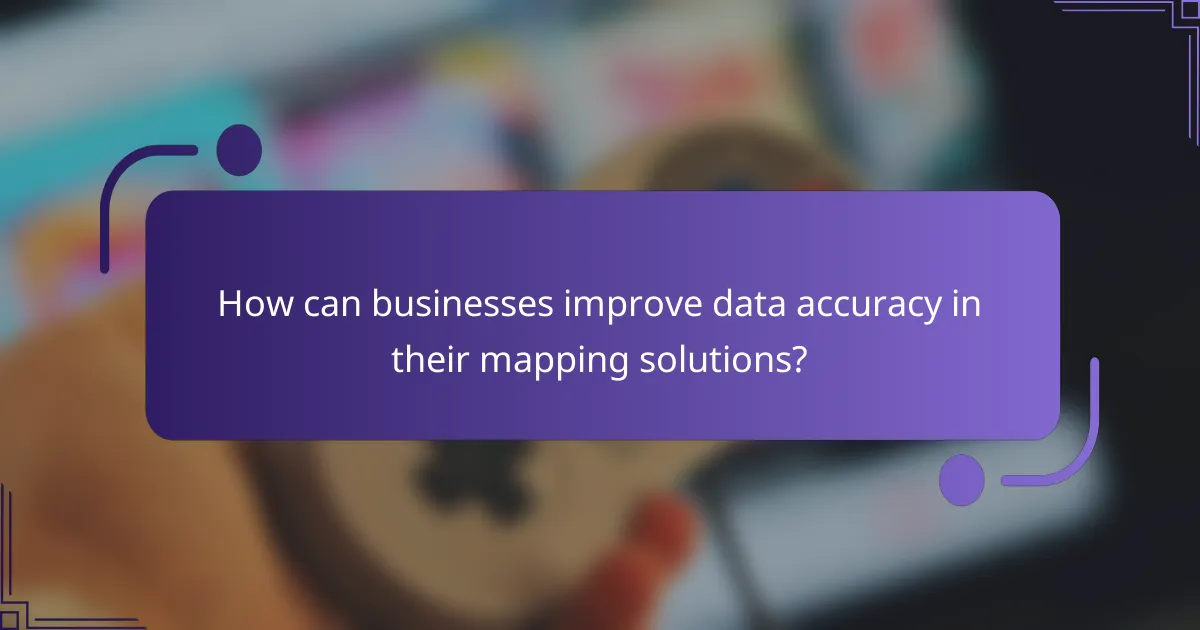
How can businesses improve data accuracy in their mapping solutions?
Businesses can enhance data accuracy in mapping solutions by implementing systematic processes such as regular audits, forming partnerships with reliable data providers, and leveraging crowdsourced information. These strategies help ensure that the data remains current, relevant, and trustworthy, which is essential for user engagement.
Regular data audits
Conducting regular data audits is crucial for maintaining the accuracy of mapping solutions. These audits involve systematically reviewing and verifying the data against reliable sources to identify discrepancies or outdated information. Businesses should schedule these audits at least quarterly to ensure ongoing data integrity.
During an audit, focus on key metrics such as location accuracy, completeness, and consistency. Tools like automated data validation software can streamline this process, reducing manual effort and increasing efficiency.
Partnerships with data providers
Forming partnerships with reputable data providers can significantly enhance the accuracy of mapping solutions. These partnerships allow businesses to access high-quality, up-to-date data that is often more reliable than what can be collected independently. Look for providers that adhere to industry standards and have a proven track record.
When selecting data partners, consider factors such as the frequency of data updates, the geographic coverage they offer, and their data validation processes. Establishing clear communication channels with these partners can also facilitate quick resolution of any data issues that may arise.
Utilizing crowdsourced data
Utilizing crowdsourced data can be an effective way to improve mapping accuracy, as it allows users to contribute real-time information about locations and conditions. This approach can fill gaps in data coverage and provide insights that traditional data sources may miss. However, it is essential to implement verification mechanisms to ensure the quality of the crowdsourced information.
Encourage user participation by offering incentives for accurate contributions, such as recognition or rewards. Additionally, consider integrating user feedback loops to continuously refine and improve the data based on community input, fostering a sense of ownership among users.
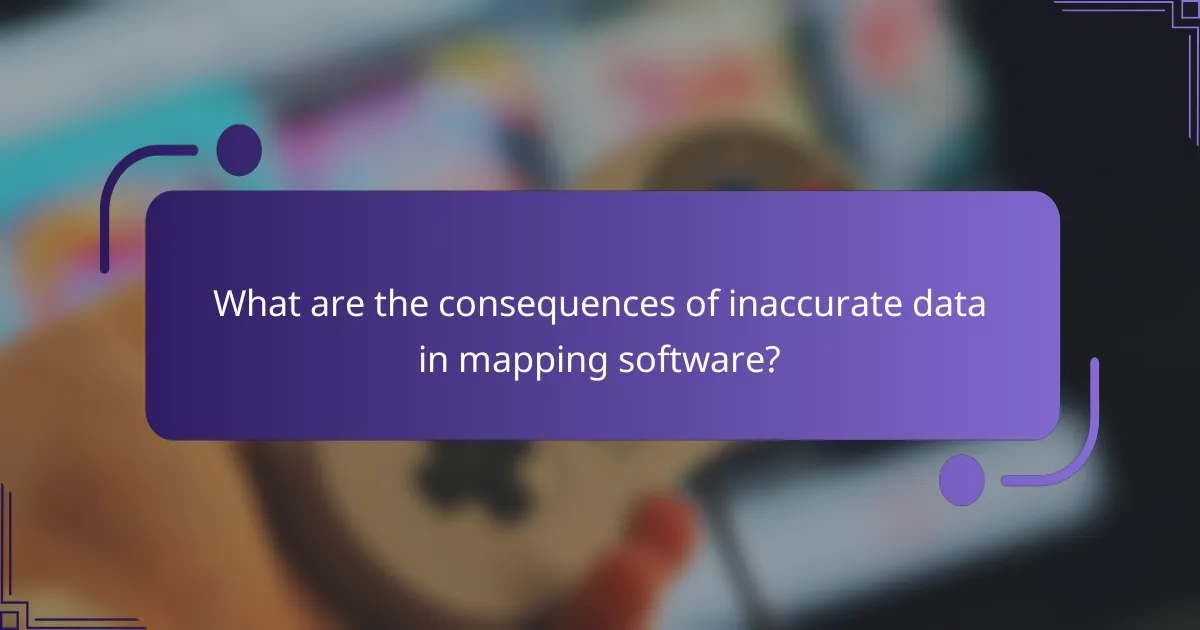
What are the consequences of inaccurate data in mapping software?
Inaccurate data in mapping software can lead to significant issues, including loss of user trust, increased operational costs, and negative impacts on user engagement. These consequences can affect both individual users and organizations relying on precise mapping for decision-making.
Loss of user trust
When mapping software provides incorrect information, users quickly lose confidence in its reliability. Trust is crucial for user retention; once it is broken, users may abandon the software for alternatives, impacting market share.
To rebuild trust, it is essential for developers to implement regular data audits and updates. Transparency about data sources and accuracy can also help regain user confidence.
Increased operational costs
Inaccurate data can lead to costly mistakes, such as misrouting deliveries or inefficient resource allocation. These errors often require additional time and money to rectify, resulting in increased operational expenses.
Organizations should invest in robust data validation processes to minimize inaccuracies. Utilizing real-time data updates can also help reduce the risk of operational inefficiencies and associated costs.
Negative impact on user engagement
Users are less likely to engage with mapping software that frequently provides inaccurate information. This disengagement can manifest as reduced usage frequency or abandonment of the software altogether.
To enhance user engagement, developers should focus on improving data accuracy and providing features that allow users to report errors. Engaging users in the data correction process can also foster a sense of community and investment in the software’s reliability.
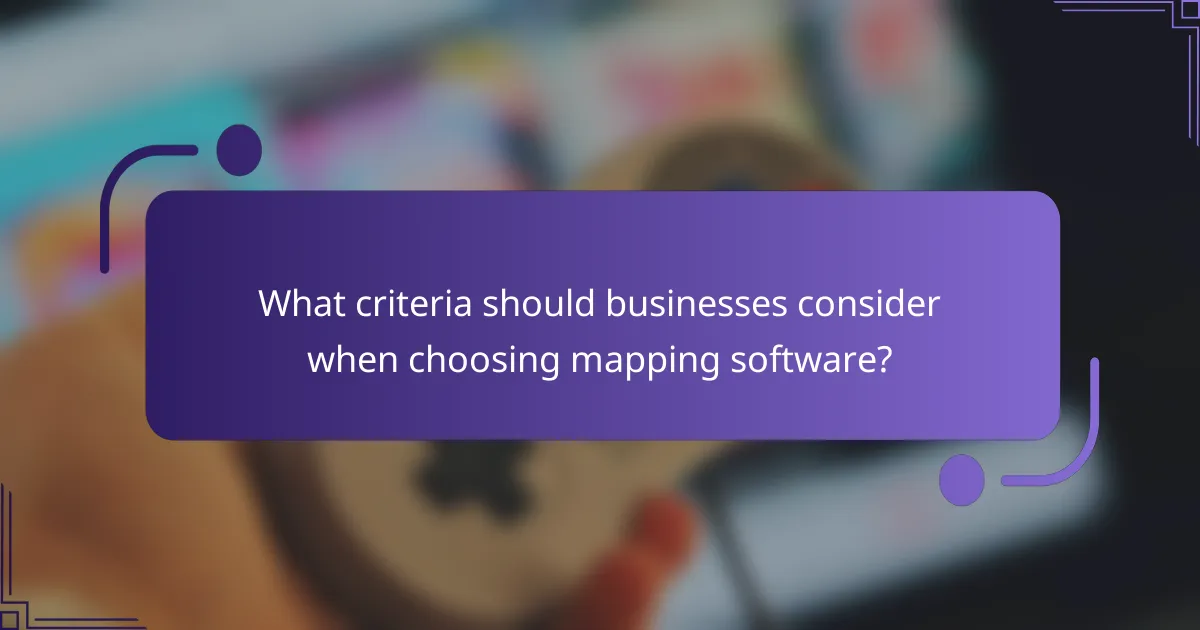
What criteria should businesses consider when choosing mapping software?
Businesses should prioritize data accuracy, integration capabilities, and user interface design when selecting mapping software. These factors significantly influence user trust and engagement, ultimately affecting the software’s effectiveness in meeting business needs.
Data accuracy metrics
Data accuracy metrics are essential for evaluating mapping software. Businesses should look for software that provides clear metrics on location precision, update frequency, and error rates. For instance, a mapping solution with an accuracy rate of over 95% is generally considered reliable.
Additionally, consider how the software sources its data. Options that aggregate data from multiple reputable sources tend to offer higher accuracy. Regular updates and user feedback mechanisms can also enhance data reliability.
Integration capabilities
Integration capabilities determine how well mapping software can work with existing systems. Look for solutions that easily connect with customer relationship management (CRM) tools, geographic information systems (GIS), and other relevant applications. This interoperability can streamline workflows and improve data sharing.
Evaluate the software’s API availability and documentation, as robust APIs facilitate smoother integrations. Businesses should also consider whether the software supports popular formats and protocols, which can simplify data exchange.
User interface design
User interface design plays a critical role in user engagement with mapping software. A clean, intuitive interface can enhance user experience, making it easier for team members to navigate and utilize the software effectively. Features like customizable dashboards and easy-to-read maps can significantly improve usability.
When assessing user interface design, consider conducting user testing or gathering feedback from potential users. This can help identify any usability issues early on and ensure that the software meets the needs of its intended audience.
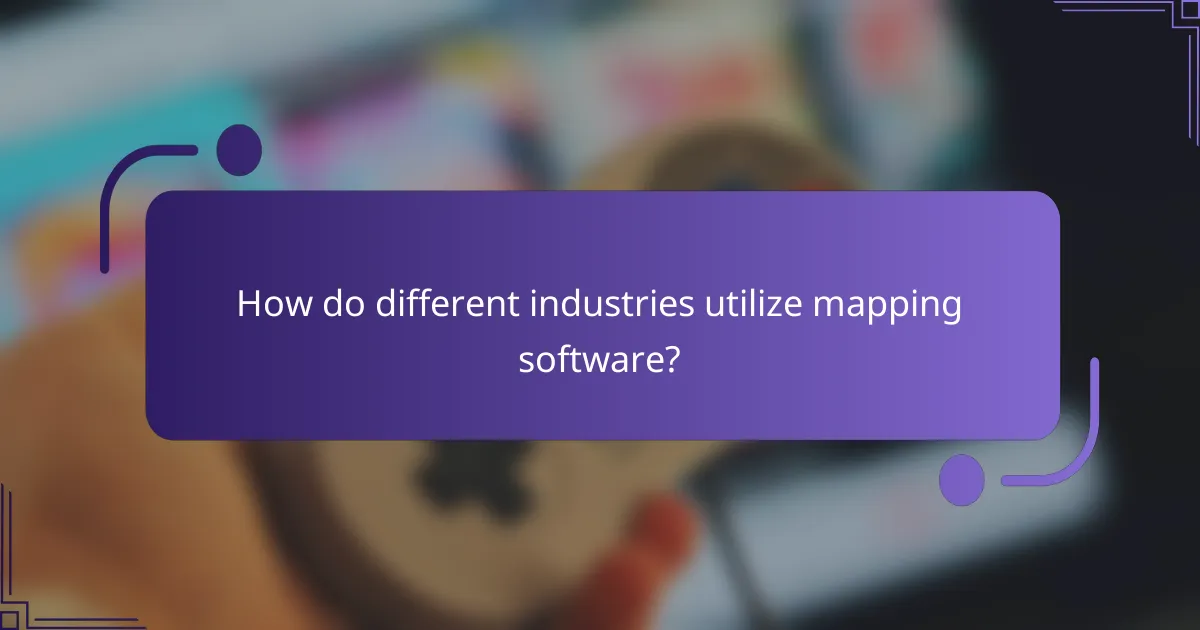
How do different industries utilize mapping software?
Mapping software is essential across various industries, enhancing operational efficiency and decision-making. It provides critical location-based insights that help businesses optimize their processes and improve customer engagement.
Logistics and transportation
In logistics and transportation, mapping software is used to optimize routes, manage fleet operations, and track shipments in real-time. By analyzing traffic patterns and road conditions, companies can reduce delivery times and fuel costs, which directly impacts their bottom line.
For instance, a logistics company might use mapping tools to determine the most efficient route for a delivery truck, taking into account factors like distance, traffic congestion, and weather conditions. This can lead to savings of several percent in fuel expenses and improved customer satisfaction through timely deliveries.
To maximize the benefits of mapping software, logistics managers should regularly update their data sources and ensure their teams are trained on the latest features. Avoid relying solely on outdated maps or static data, as this can lead to inefficiencies and increased operational costs.
